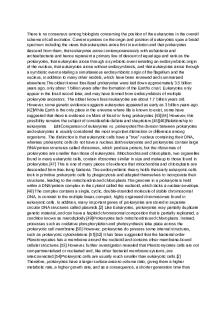Oogenesis - Lecture notes 5 PDF

| Title | Oogenesis - Lecture notes 5 |
|---|---|
| Course | Human Anatomy and Physiology with Lab II |
| Institution | The University of Texas at Dallas |
| Pages | 2 |
| File Size | 70.6 KB |
| File Type | |
| Total Downloads | 14 |
| Total Views | 159 |
Summary
oogenesis description and its mechanism...
Description
Oogenesis In females, oogonia are the primordial (earliest) egg cells. They are replicated by mitotic division in the ovaries. As many as 10 million oogonia can be produced in human females; however, the large majority will apoptose and die. Only about 50,000 oogonia will remain (exact numbers aren’t important – just know that many oogonia are produced, and there is major apoptosis, with only a small fraction remaining). These remaining cells will differentiate into primary oocytes, which will begin the first meiotic division, but will not complete meiosis I. Meiosis I will be arrested in prophase I until puberty.
Once a female hits puberty, every month one of these eggs will be stimulated to develop in the process of ovulation. This ovulated egg will complete the first meiotic division, producing a large secondary oocyte and a polar body (the polar body may or may not go onto divide again through meiosis II). The secondary oocyte is large because it keeps most of the cytoplasm from this division. The polar body is a small daughter cell which lacks most organelles, and will atrophy away. This secondary oocyte will then arrest in metaphase II.
Only if fertilization occurs will the egg be stimulated to complete meiosis II. If the egg is fertilized and goes onto complete meiosis II, 2-3 polar bodies will have been produced (depending on if the first polar body completed another division). However, only the oocyte can produce viable offspring (not the polar bodies) because the vast majority of the nutrients and cytoplasm in the progenitor cells go into making the oocyte viable (the polar bodies receive very little cytoplasm from each division).
Sperm contribute very little cytoplasm or nutrients to the fertilized egg, and it is the responsibility of the high-investment oocyte to provide enough nutrients for the offspring to survive.
Hormones in Females In females, Follicle Stimulating Hormone (FSH) stimulates follicles in the ovary to develop. The follicle produces female sex hormones (progesterone and estrogen).
A surge in Luteinizing Hormone (LH) causes ovulation of an egg and formation of the corpus luteum. The corpus luteum also produces female sex hormones (progesterone and estrogen).
Mnemonic: Follicle stimulating hormone stimulates the follicle to develop – this makes intuitive sense based on the name follicle stimulating hormone. Luteinizing hormone causes ovulation of the egg and formation of the corpus luteum – this makes intuitive sense based on the name luteinizing hormone.
Estrogen and progesterone are female sex hormones (although males do have varying levels of estrogen as well). They contribute to the menstrual cycle and reproduction, as well as female secondary sex characteristics (eg. breast development)....
Similar Free PDFs

Oogenesis - Lecture notes 5
- 2 Pages

Oogenesis - Lecture notes 1-3
- 3 Pages

5 - Lecture notes 5
- 4 Pages

Chapter 5 - Lecture notes 5
- 15 Pages

Chapter-5 - Lecture notes 5
- 6 Pages

Chapter 5 - Lecture notes 5
- 83 Pages

Tutorial 5 - Lecture notes 5
- 3 Pages

Chapter 5 - Lecture notes 5
- 4 Pages

Imagen 5 - Lecture notes 5
- 1 Pages

Quiz 5 - Lecture notes 5
- 11 Pages

Chapter 5 - Lecture notes 5
- 20 Pages

Chapter 5 - Lecture notes 5
- 4 Pages

Lesson 5 - Lecture notes 5
- 22 Pages

5 Statehood - Lecture notes 5
- 4 Pages

Prokaryotes 5 - Lecture notes 5
- 2 Pages

5. Conduct - Lecture notes 5
- 4 Pages
Popular Institutions
- Tinajero National High School - Annex
- Politeknik Caltex Riau
- Yokohama City University
- SGT University
- University of Al-Qadisiyah
- Divine Word College of Vigan
- Techniek College Rotterdam
- Universidade de Santiago
- Universiti Teknologi MARA Cawangan Johor Kampus Pasir Gudang
- Poltekkes Kemenkes Yogyakarta
- Baguio City National High School
- Colegio san marcos
- preparatoria uno
- Centro de Bachillerato Tecnológico Industrial y de Servicios No. 107
- Dalian Maritime University
- Quang Trung Secondary School
- Colegio Tecnológico en Informática
- Corporación Regional de Educación Superior
- Grupo CEDVA
- Dar Al Uloom University
- Centro de Estudios Preuniversitarios de la Universidad Nacional de Ingeniería
- 上智大学
- Aakash International School, Nuna Majara
- San Felipe Neri Catholic School
- Kang Chiao International School - New Taipei City
- Misamis Occidental National High School
- Institución Educativa Escuela Normal Juan Ladrilleros
- Kolehiyo ng Pantukan
- Batanes State College
- Instituto Continental
- Sekolah Menengah Kejuruan Kesehatan Kaltara (Tarakan)
- Colegio de La Inmaculada Concepcion - Cebu